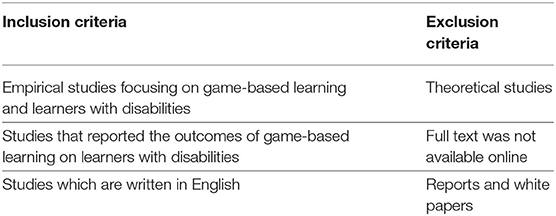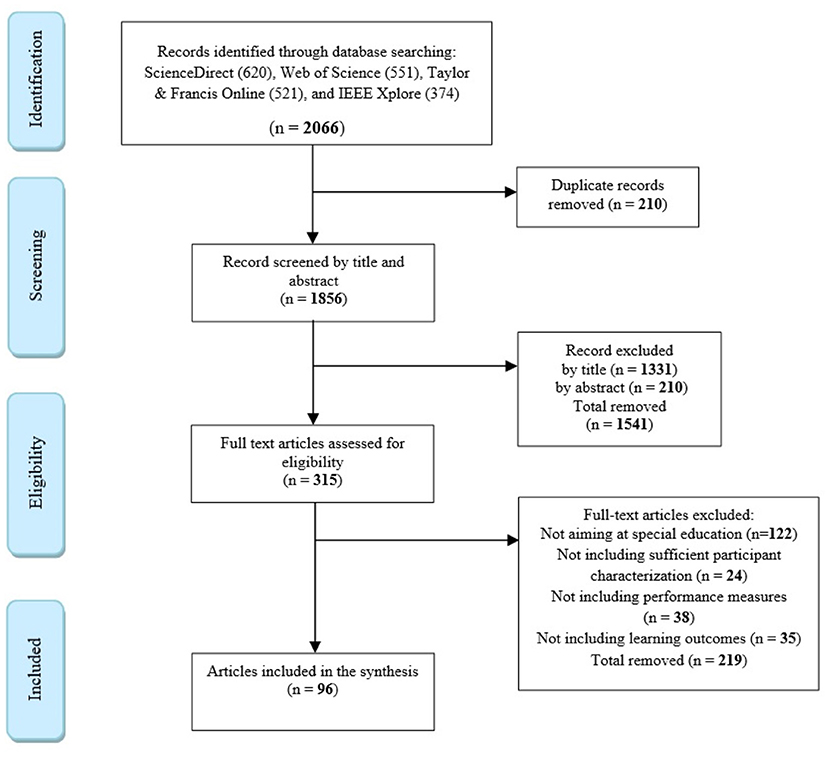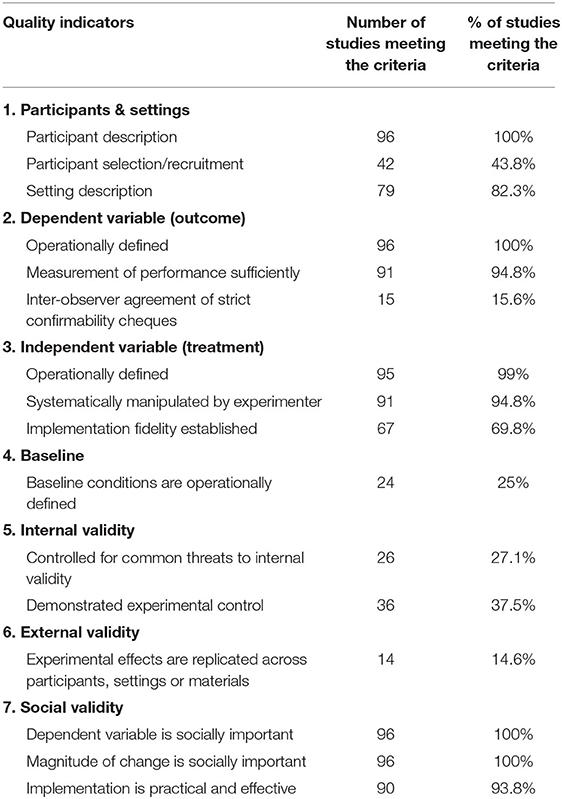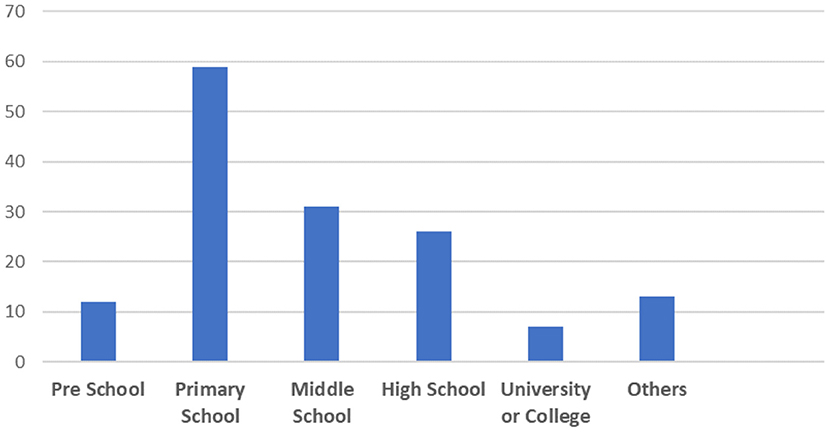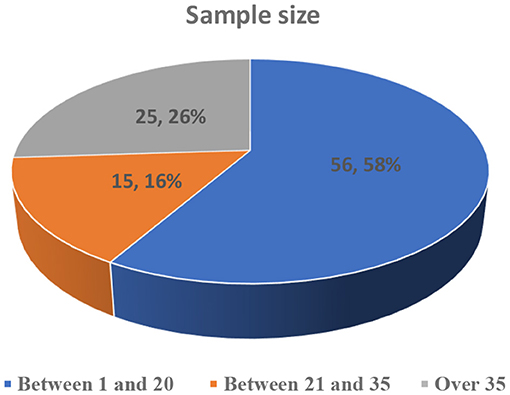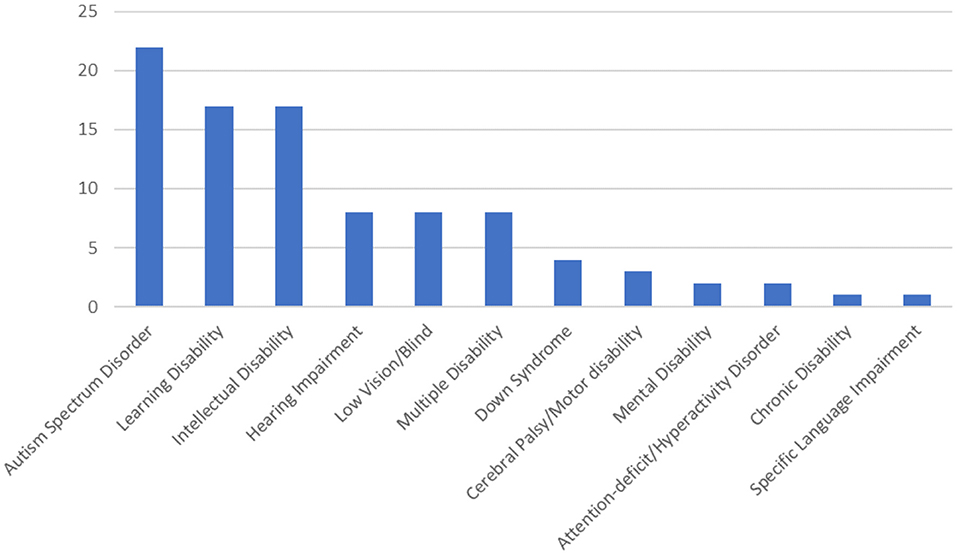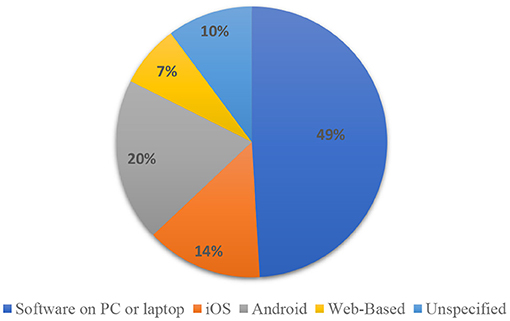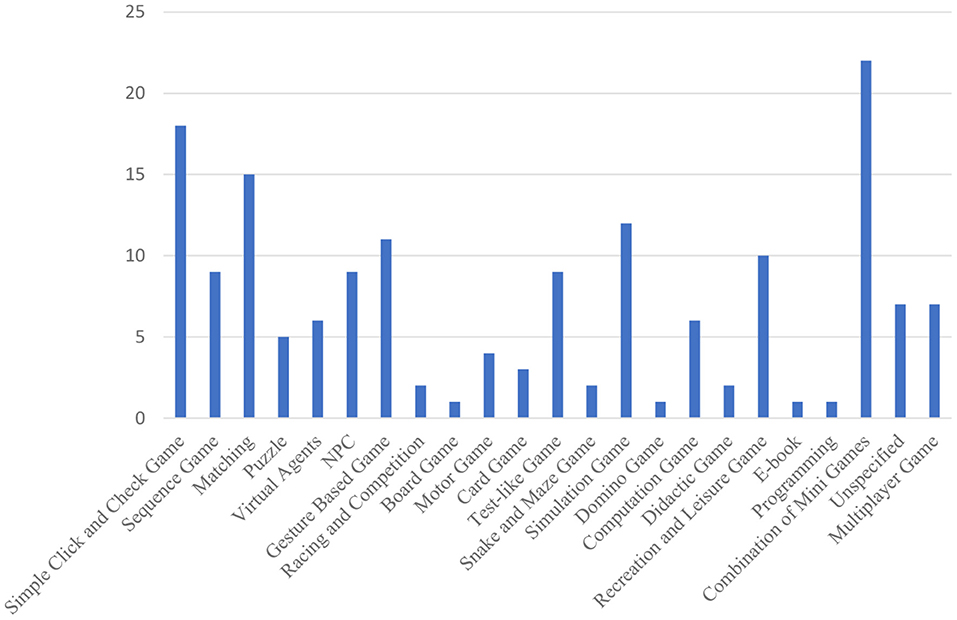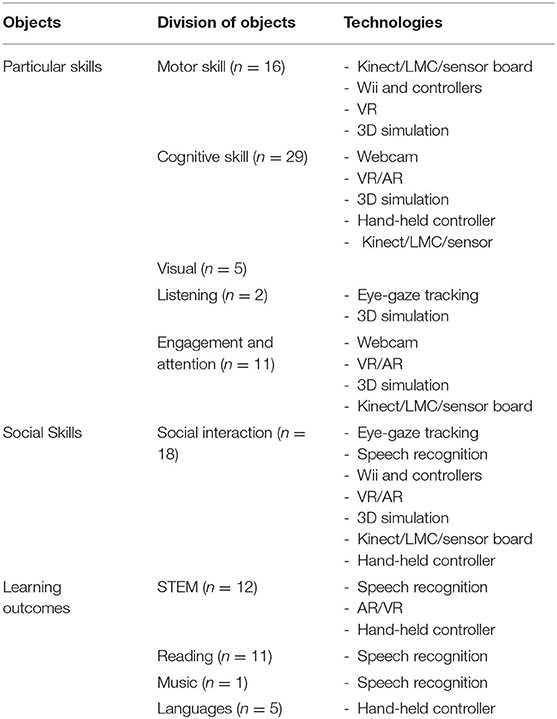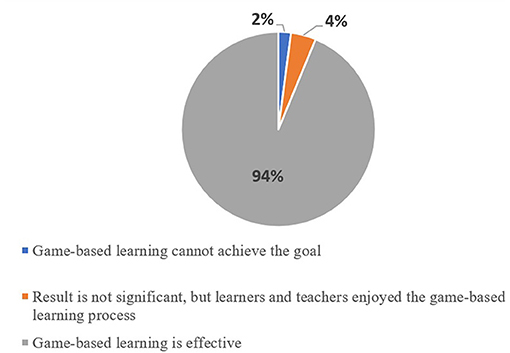- 1Smart Learning Institute of Beijing Normal University, Beijing, China
- 2University Polytechnique Hauts-de-France, LAMIH, CNRS, UMR 8201, Valenciennes, France
- 3INSA Hauts-de-France, Valenciennes, France
- 4Research Institute for Innovation & Technology in Education (UNIR iTED), Universidad Internacional de La Rioja (UNIR), Logroño, Spain
- 5Health and Behavior Studies Department, Teachers College, Columbia University, New York, NY, United States
The design, implementation, and outcome of game-based learning for learners with disabilities have not been sufficiently examined systematically. Particularly, learner-based and contextual factors, as well as the essential roles played by various stakeholders, have not been addressed when game-based learning applications are used in special education. Therefore, a systematic literature review using the Activity Theory (AT) was conducted to analyse studies about game-based learning for learners with disabilities. Content analysis of 96 studies reported relevant information with respect to each activity component—(a) subject (learners with disabilities), (b) technology (game-based learning applications), (c) object (target skills or behaviours), (d) rules (implementation procedure and performance measures), (e) community (learners with disabilities, special education professionals, and parents), (f) division of labour (among learners, professionals, and parents) and (g) outcome (performance of target skills or behaviours). Furthermore, this study identified existing gaps from the reviewed studies, including occasional lack of parental engagement, difficulty of standardising performance measures due to the heterogeneity of learner profiles and contradictions (e.g., opposing views among experts on the role of educational games in social interactions). Finally, recommendations were made under each activity component. The study concluded that both general and domain-specific guidelines should be created for each disability category proposed in this review to assist practitioners who wish to use game-based learning with learners with disabilities.
Introduction
Game-Based Learning for Learners With Disabilities
Special education aims to help learners experiencing difficulties or disabilities in regular classrooms to promote their social participation and independence (Kavale, 1990). Professionals in this area have long faced the urgency to investigate what educational practises are effective and beneficial to learners with disabilities (Moeller et al., 2015). In recent years, in response to the need for special education, several educational techniques have been identified and validated for effectiveness, including game-based learning (Anwar et al., 2011; Görgen et al., 2020).
Game-Based Learning (GBL) originated from the game research in the middle of the 1950s, and from the 1980s scholars started the research and practise of integrating games into instruction. With the popularisation of electronic games and the transformation of education concepts, users started gradually accepting games as learning tools (Seaborn and Fels, 2015). In GBL research, the following three terms are always used namely: serious games, educational games and digital educational games (Pan et al., 2021). These three terms have similarities and differences among their definitions. Therefore, clarifying their meanings and relationships can help to understand the scope of the current study. The term “serious game” was first used by Apt (1970) to describe games designed for learning. Apt stated that serious games must have an educational purpose and not be played primarily for entertainment (Apt, 1970). Educational games in a narrow sense are electronic games specially developed for educational purposes (Moreno-Ger et al., 2008). Educational games in a broad sense not only involve traditional games (Vos et al., 2011), but also include all educational software, teaching aids, toys with the characteristics of both education and fun. Educational games should be developed by considering the objectives and functions of education. Digital educational games are educational games which are supported by different information technology and digital platforms (Lin and Lin, 2014; Aslan and Balci, 2015) to promote learners' understanding of a given learning content. In this study, game-based learning is considered as any environment which uses various technology and platforms, as well as applies games or related elements, concepts, mechanisms or designs to teach a given concept or subject (Deterding et al., 2011).
Game-based learning can provide immersive learning experiences while mastering knowledge and skills. Specifically, it supports the development of analytical reasoning skills and self-directed learning, cooperative skills and group problem-solving, which are essential for learners with disabilities (Dziorny, 2007). For instance, Özen (2015) selected six iPad games as tools to promote interaction between regular developing and Autism spectrum disorder (ASD) siblings. This study was performed with peers of siblings: one with ASD and the other one without. After the training period, all three ASD children were able to satisfactorily learn abilities, which were maintained, for at least 2 weeks. Hatzigiannakoglou and Okalidou (2019) used Virtual Reality (VR) to help children with cochlear implants to be familiar with the device and to develop auditory skills based on Erber's model. In this game, children learn to recognise animal sounds, discriminate sounds and understand simple orders. Particularly, eye tracking was the mechanism to interact with the game, in which the youngest children needed additional help. However, after the experiment, the authors concluded that neither eye tracking nor VR headset led to difficulties for individuals in the sample, which turned them into proper devices for this kind of training. Another proposal for hearing impairment was from Bouzid et al. (2016), who proposed the computer game MemoSign to teach sign language. This game is based on the Memory Match Game, which includes a 3D human character who reproduces signs to facilitate the learning process for users. In this experiment, nine deaf users reported good experiences towards the game and found it useful.
Rationale and Study Objectives
Several literature reviews were conducted on the use of game-based learning in special education. However, it is seen that most existing literature reviews were concerned with the examination of the effectiveness of game-based learning on a specific disability. For instance, Lämsä et al. (2018) reviewed 20 studies that addressed learning disabilities by employing game-based technological applications to support learners' basic reading and math skills. Additionally, Stančin et al. (2020) explored 21 studies related to the use of digital-assisted educational games for learners with intellectual disability. As these studies can only provide a partial picture of the use of game-based learning in the realm of special education, a comprehensive review of how to apply educational games to enhance the learning of individuals with diverse disability profiles is necessary. Consequently, this review is intended to fill this gap by including different disabilities (e.g., hearing impairment, autism spectrum disorder, and intellectual disability). Additionally, several literature reviews related to game-based learning and special education focused on the technology assessment perspective in terms of the adopted operating system and technology (Stančin et al., 2020). However, limited findings were presented in the literature about how learners with different disabilities might perceive game-based learning, stakeholders involved in the learning process and which elements should be considered when designing game-based learning for learners with disabilities.
Therefore, to address this research gap, this study relies on the Activity Theory (AT) framework to conduct a systematic review of the literature related to game-based learning and learners with disabilities and present its findings. AT describes the contributions of and interconnectedness among each stakeholder of an activity, the process of which is also mediated by other individual and social factors (Engeström, 2001). It focuses on six components of an activity, namely: subject, object, tool, rules, community, and division of labour (Engeström, 2001). Since complex and interacting factors affect the design and perceptions of tools in special education (Pearson, 2009), it is crucial to move beyond the technology itself and understand how different stakeholders can collaborate (e.g., identifying disability profiles, standard practises, and distributed duties) to achieve a goal. As such, an analysis based on AT, which has been applied in numerous domain areas, will help increase the effectiveness of using game-based learning for learners with disabilities.
AT has been adopted to examine the use of several types of technology in both general and special education settings (e.g., Daniels and Cole, 2002; Tlili et al., 2020). However, to the best of our knowledge, the theory has not been used to analyse the design and implementation of game-based learning for learners with disabilities. Specifically, this study aims to answer the following research questions:
RQ1. Through the lens of AT, what relevant features can be identified concerning the design, implementation and outcome of game-based learning for learners with disabilities?
RQ2. What recommendations can be made to improve research related to game-based learning for learners with disabilities?
Method
This study presents a systematic literature review based on published papers related to the use of game-based learning with learners with disabilities. The Preferred Reporting Items for Systematic Reviews and Meta-Analyses (PRISMA) guidelines were followed to produce this systematic review (Moher et al., 2010). PRISMA provides a standard peer-accepted methodology that uses a guideline checklist, which was strictly followed in this paper.
Search Strategy and Inclusion/Exclusion Process
To deal with this complex topic, an extensive search for research papers and articles was conducted based on the following search strings.
Search string: (game-based learning) AND (special education).
Game-based learning substring: game-based learning OR educational games OR serious games OR educational gamification OR gameful learning OR gamified learning.
Special education substring: special education OR learners with special needs OR students with special needs OR learners with disabilities OR students with disabilities.
The literature search was undertaken using Taylor & Francis Online, IEEE Xplore Digital Library, ScienceDirect, and Web of Science. After searching the relevant databases, two authors analysed the retrieved papers by title, abstract and if necessary, by full text based on a predefined inclusion and exclusion criteria defined in Table 1. Because of the novelty of the topic and the aim to provide comprehensive insights into game-based learning for learners with disabilities, conference papers were considered. Additionally, the time range was not specified.
This research yielded a total of 2,066 articles. After removing duplicate papers, 1,856 papers remained. A total of 1,541 papers were then removed after screening titles and abstracts. The remaining 315 papers were considered and assessed as full texts; 219 of these papers did not pass the inclusion criteria. Thus, a total of 96 studies were eligible for further analysis. Figure 1 presents the study selection process as recommended by the PRISMA group (Moher et al., 2010). Finally, based on the degree of agreement between the choices made by the two independent authors in selecting papers, Cohen's kappa was calculated to test inter-rater reliability. According to Cohen (1960), the obtained inter-rater reliability was strong (κ = 0.88); in case the assessment score was different, agreement was reached through discussions.
Research Rigour and Design of the Selected Studies
Horner's criteria, a widely adopted rubric for case design in special education (Moeller et al., 2015), was used to assess research rigour. This set of criteria was valid because case design is commonly used in special education research, and a large proportion of the selected studies employed case design. To ensure the credibility of Horner's quality indicators, the researchers checked them against the essential quality indicators for experimental research in special education (Gersten et al., 2005) and found that Horner's criteria sufficiently fulfilled items for describing participants, implementation of the intervention and description of comparison conditions and outcome measures. Horner's criteria further assessed the social validity of case design (Moeller et al., 2015). Compared to ideal indicators for measuring qualitative methodological rigour in general education research, Horner's criteria adequately ensured responsiveness to social context, appropriateness of sampling, adequacy of sampling and transparency of data collection (Fossey et al., 2002). As shown in Table 2, low percentages were reported for establishing baseline conditions (25%) and ensuring experimental control (37.5%), implying challenges faced by special education practitioners when designing and implementing game-based learning interventions.
Using Activity Theory to Analyse Studies on Game-Based Learning for Learners With Disabilities
This review adopted AT to perform content analysis on the interplay of various components and actors involved in research on game-based learning for learners with disabilities. Since activity is defined as a system of purposeful behaviours leading to recognisable changes in human practises (Kim, 2010), the researchers examined how game-based learning could help evolve behaviours and practises among stakeholders. As shown in Figure 2, the framework addressed how game-based learning applications and tools were adapted for learning, as well as their learning outcomes. Additionally, it investigated how special education professionals created and perceived the learning environment enriched by game-based learning activities and how parents were involved in these interventions.
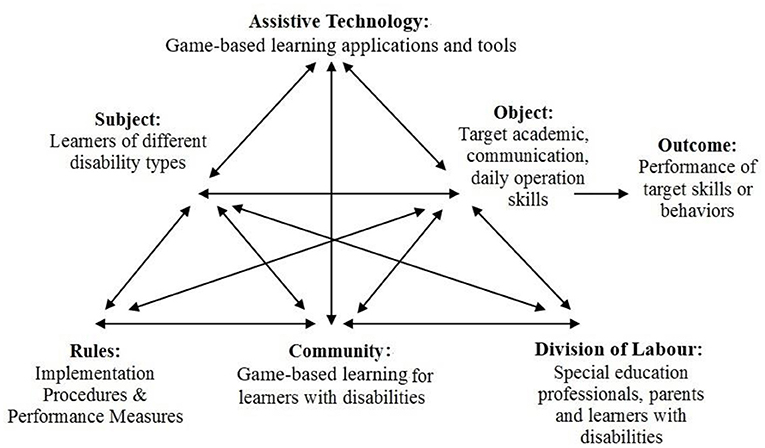
Figure 2. Using activity theory to analyse studies on game-based learning for learners with disabilities.
Subject referred to learners with one or more different disabilities who participate in game-based learning research; Technology referred to the game-based learning used and its genre, as well as the accompanying tools; Object included learners' skills and behaviours that game-based learning aims to improve (e.g., academic, communicative, social/interactional, and movement); Rules included accepted practises in implementing game-based learning interventions, such as intervention procedures and performance measures for evaluating learning outcomes; Community referred to the people involved in game-based learning interventions (e.g., learners, family, friends, professionals) and special education settings (e.g., schools, clinics) that support these interventions; Division of labour referred to the distribution of duties among learners, special education professionals and parents to undertake game-based learning interventions and Outcome pertained to learners' performance in target skills as evaluated by performance measures.
Results and Discussion
To address the first research question, findings based on the 96 studies showed the design features of learning activities for different disability categories supported by different hardware and instructional strategies, research implementation processes enacted by various stakeholders and outcome evaluation in game-based learning. To answer the second research question, recommendations on how to improve game-based learning for learners with disabilities were provided based on the identified gaps, challenges or contradictions under each activity component.
Subject
Based on the analysis of the collected studies, Figure 3 presents the distribution of studies by education level. Of these, 12 focused on learners in preschool (e.g., RuŽičková and Hordějčuková, 2015; Al Mahmud and Soysa, 2020), 60 involved learners in primary school (e.g., Hulusic and Pistoljevic, 2012; Bernardini et al., 2014), 32 had learners in middle school (e.g., Hetzroni and Banin, 2017; Sari et al., 2019), 27 had learners in high school (Hollingsworth and Woodward, 1993; Sherrow et al., 2016), seven focused on learners in colleges or universities (e.g., Cano et al., 2019) and thirteen were classified as “others” because they examined learners who were not in school/university (e.g., Segatto et al., 2017) or did not specify learners' education level (e.g., Rahmadiva et al., 2019). It should be noted that 32 studies involved learners in more than one education level. For instance, 17 had learners in primary school, middle school and high school (e.g., Bouzid et al., 2016).
Figure 4 shows the distribution of studies based on their sample size. More than half of the studies (56%) had sample sizes <20 learners (e.g., Hulusic and Pistoljevic, 2012; Kang and Chang, 2019). Meanwhile, 25% of the studies had sample sizes >35 (e.g., Bakker et al., 2016; Lau et al., 2020).
Figure 5 shows the distribution of studies based on learners' disabilities. Majority of the 96 reviewed studies focused on learners with Autism Spectrum Disorder (ASD, n = 23), Intellectual Disability (n = 17), and Learning Disability (n = 14). Particularly, “learners with ASD demonstrate problems in social engagement, impatient in turn-taking, and waiting that could potentially affect their day-to-day activities and their quality of life” as cited in Al Mahmud and Soysa (2020), and these aspects have led to studies on teaching children with ASD skills including social interaction, sequencing, and the acquisition of physical movement and are closely related to daily scenarios (Özen, 2015; Cai et al., 2018; Hassani et al., 2020).
Four studies on learning disabilities focused on learners' reading deficiency (e.g., reading disabilities and attention deficits, “Maghzineh,” reading training, multicomponent reading game) (Cassar and Jang, 2010; van de Ven et al., 2017; Kashani-Vahid et al., 2019; Görgen et al., 2020), while another four focused on reasoning and math-related solving skills (Margalit et al., 1987; Christensen and Gerber, 1990; Hollingsworth and Woodward, 1993; Bakker et al., 2016).
Learners with intellectual disability often suffer from significant impairments including conceptual, social or practical, adaptive and motor skills and show limited academic achievement including motivation, engagement and determination in comparison to age expectations (Main et al., 2016). Seventeen studies involved learners with intellectual disability and examined the use of games in improving above mentioned skills.
Eight studies included participants with multiple types of disabilities (Valentini et al., 2017; Ojeda-Castelo et al., 2018). For example, four learners with different characteristics including visual impairment, hearing impairment, physical disability, and autism participated in the testing of an application for learning and rehabilitation in special educational needs (Ojeda-Castelo et al., 2018). Ten studies included learners with hearing impairments, mostly with cochlear implants while two studies involved learners with deafness (Tobar-Munoz et al., 2014; Bouzid et al., 2016). Eight studies involved learners with visual impairment (Sepchat et al., 2006; RuŽičková and Hordějčuková, 2015; Ciman et al., 2018; De Biase et al., 2018; Matas et al., 2019; Neto L. et al., 2019; Neto L. V. et al., 2019; Sari et al., 2019; Neto et al., 2020).
Four studies concerned learners with Cerebral Palsy (CP) and related neuromuscular disability. Three studies involved learners with dyslexia, where reading and writing complications often occur (Malekian and Askari, 2013; Gooch et al., 2015; El Kah and Lakhouaja, 2018). Four studies examined the performance of users with Down Syndrome, while one study included users with traumatic brain injury (Everhart et al., 2011). A total of six studies involves learners with intellectual disability, Attention deficit hyperactivity disorder (ADHD), chronic disorders and specific language impairment.
Challenges
Two main challenges for the Subject component were identified. First, most studies had small sample sizes. Similarly, studies that focused on reviewing educational technologies in relation to learners with disabilities reported the same challenge (e.g., Tlili et al., 2020). The second challenge involves the diversity of learners' disability profiles when conducting a game-based learning experience. Consequently, the designed game or experiment might be convenient for one disability type but not for another.
Recommendations
To improve the usability and accessibility of the Subject component, commonly used guidelines, such as World Wide Web Consortium (W3C), on designing inclusive game-based learning with regard to each disability can be collected and categorised into an open-source repository for future reference. Such guidelines will promote practitioners' efficiency in designing game-based learning while maintaining a high level of accessibility and appropriateness for learners with different disabilities. For instance, design strategies for games involving learners with two yet distinct disabilities could adopt guidelines under those two categories, demonstrating accessibility for all learners (Valentini et al., 2017; Ojeda-Castelo et al., 2018).
To increase sample size, multiple strategies should be considered, as the number of learners with certain types of disability is limited in given areas. First, associations with local special learning centres, special schools and universities can be formed. The first two often have many learners whose profiles are clearly documented; hence, administrative workload on filtering and selecting learners will be lessened. Moreover, given their stable background and sites, systematic studies can be conducted, decreasing the dropout rate of learners during the experiments. Collaborating with universities is also a good option because they usually have advanced corollary equipment and undergrad research volunteers who help monitor the process. Second, researchers can utilise publicity that keeps pace with the times. The Internet is a great way to deliver information, and it plays and will continue to play a significant role post COVID-19. Leaflets could be replaced by e-mails and advertisements sent to individual family or online communities. Third, snowball sampling can be used to tap more users by “asking participants to pass along recruitment information to other potential participants” (Ghanouni et al., 2020). Lastly, working with local schools may also increase sample size, but consideration and caution must be given to learners' prior knowledge and learning environments. In this context, Valentini et al. (2017) and Ghanouni et al. (2020) mentioned that universities should collaborate with associations to enhance accessible learning.
Technology
The Technology component was divided into three main dimensions, namely: platform, technology and game type. The platform consists of five categories: (a) iOS on iPhone or iPad (Al Mahmud and Soysa, 2020), (b) Android on phone or tablet (Bendak, 2018), (c) software on PC or laptop (Navarro-Newball et al., 2014), (d) web-based (Buzzi et al., 2019), and (e) unspecified (García-Redondo et al., 2019). Figure 6 shows that half of the games were played on a PC or laptop using Windows (e.g., Bendak, 2018), Linux (e.g., Groenewegen et al., 2008) or MacOS (e.g., Pontes et al., 2020). About 32% of the studies used mobile game–based learning, where 19% were on Android (19%) while 13% were on iOS (e.g., Doenyas et al., 2014). Around 7% of the studies used web-based platforms (e.g., Matas et al., 2019; Nisansala and Morawaka, 2019), which can be played on any type of device regardless of the operating system. Finally, 11% of the studies did not specify the operating system (e.g., Malekian and Askari, 2013; Delavarian et al., 2015).
Figure 7 shows that 24 studies had a combination of mini games (Wegrzyn et al., 2012). Nearly half of them had targeted learners with different learning disabilities, such as reading disability and math disability. Eighteen studies had games involving simple “click and check,” where players interact with the game using the mouse or pointing at the touchscreen. The adoptions of real settings and events such as feeding animals (e.g., Kuswardhana et al., 2015), taking a shower (e.g., Kang and Chang, 2019), taking the subway (e.g., Cano et al., 2019) and making a salad (e.g., Kirshner et al., 2011; Isasi et al., 2013) simulate real-life scenarios and help learners get used to and be aware of surrounding environments. Storyline and non-player characters (e.g., Navarro-Newball et al., 2014; Stylianidou et al., 2020) were also widely used to help learners obtain a sense of control of the learning environment.
Strategies for math and reading development within the designed game-based learning included sequencing (Kosmas et al., 2018), matching (Tobar-Munoz et al., 2014), computation (Christensen and Gerber, 1990) and test or quiz (Bendak, 2018). To improve motor skills and cooperation ability, group work (Creighton and Szymkowiak, 2014) and social interactional learning (Özen, 2015) were employed. Finally, to train executive functions and concentration, strategies such as learning-by-doing (Kang and Chang, 2019) and integrating real settings (Kuswardhana et al., 2015) were used. Table 3 shows the eight types of technologies used in game-based learning. Eye-gaze tracking was used in game-based learning, which aimed to improve learners' attentional interaction (e.g., Bernardini et al., 2014) and auditory skills and monitor their performance (e.g., Hatzigiannakoglou and Okalidou, 2019). A webcam was used to enhance learners' psychomotor development (e.g., Karal et al., 2010), memory skills and emotional state (e.g., Kosmas et al., 2018). Speech recognition technology was used to reinforce learners' speech (e.g., Navarro-Newball et al., 2014) and reading and math skills (e.g., Nisansala and Morawaka, 2019). Wii and controllers were used in two educational games that focused on improving learners' engagement and cooperation (e.g., Creighton and Szymkowiak, 2014) and recreation and leisure skills (e.g., Sherrow et al., 2016). Augmented Reality (AR) and VR technologies were used to improve learners' engagement and focus (e.g., Pourazar et al., 2019; Rahmadiva et al., 2019; Stylianidou et al., 2020), hand–eye coordination (e.g., Lu et al., 2018), cognitive reinforcement (e.g., Groenewegen et al., 2008; Kurniawati et al., 2019) and the teaching of pairing and ordering (e.g., Tobar-Munoz et al., 2014). 3D simulation was often included alongside VR and AR in improving learners' key skills, personal development, and work sustainability (e.g., Flogie et al., 2020). Five types of external devices were found, including a trapezoid device with four buttons to address ineffective learning behaviour (e.g., Segatto et al., 2017); a probe on a board for practising everyday tasks in navigation, orientation and cognitive planning (e.g., Groenewegen et al., 2008); handheld game console for enhancing learners' mental and math skills (Main et al., 2016); a tile intended to improve learners' memory, communication, thinking and understanding (Saleh et al., 2013) and a Braille terminal designed for visually impaired learners to develop their touch and familiarise themselves with and learn Braille (Sepchat et al., 2006). Twelve studies incorporated either Kinect, Leap Motion Controller (LMC) or a sensor board in game-based learning. Nine studies focused on enhancing learners' physical ability, motor skill, hand–eye coordination, and motion control (Ojeda-Castelo et al., 2018; Shalash et al., 2018; Kang and Chang, 2019). Five used game-based learning to reinforce cognitive skills (Cai et al., 2018; Kosmas et al., 2018), while three adopted game-based learning to improve learners' concentration level (Kuswardhana et al., 2015; Rahmadiva et al., 2019).
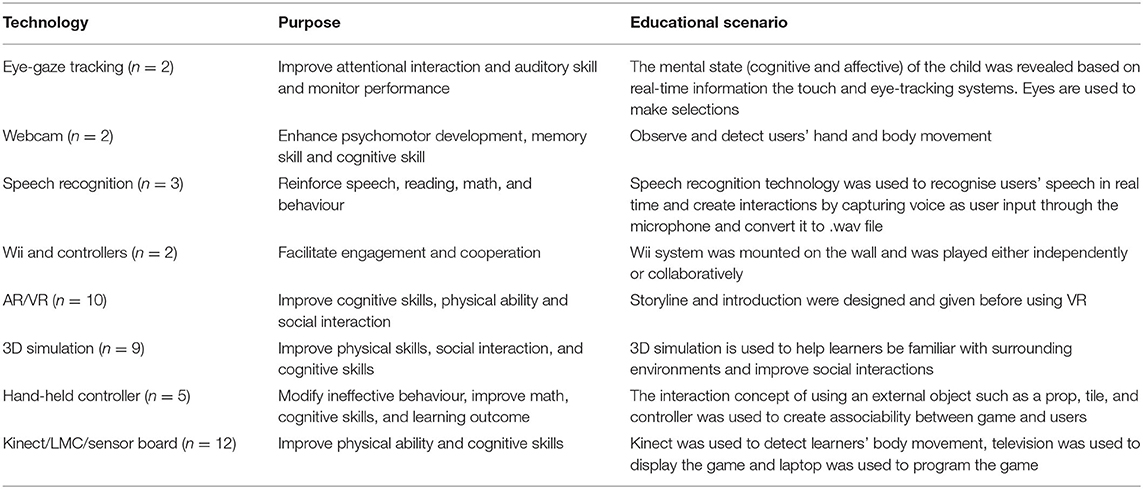
Table 3. Learning purposes and scenarios with different types of technology within game-based learning.
Table 3 presents the types of technology used in each study as well as their purposes and game scenarios. It can be seen that VR/AR (n = 10), 3D simulation (n = 9), and Kinect (n = 12) were the most popular technologies used.
Challenges
Restricted interchangeability of operating systems and technical problems have been related to the challenges of using technology in designing and implementing game-based learning. For instance, among the 96 reviewed studies, only 15 games could be installed and played on iOS and 21 on Android. Even though the market is fragmented in terms of operating systems, “supporting only a particular device/operating system could strongly reduce the number of potential users, hence reducing the possible benefits of application” (Ciman et al., 2018). Additionally, issues have been found around certain types of technologies. For example, speech recognition experiences time lag “which contrasted with the fast game mechanics, causing some frustration in children” (Navarro-Newball et al., 2014); the Kinect camera can observe learners' movements but has difficulty interpreting performance accurately (Cai et al., 2018); the eye-tracking system has difficulty not only in applying the corresponding model but also in collecting reliable data because of the “naturalistic context in which the system was used with the child standing and being allowed to move freely” (Bernardini et al., 2014).
Recommendations
It is encouraged to use cross-platform design frameworks when developing game-based learning so that they can be deployed in devices with a wide range of operating systems, including iOS, Android, Linux and Windows. Additionally, to minimise technical problems, studies must select the appropriate experimental environment and context, such as games that involve slow narration where time lag is not significant. In this context, a usability experiment should be conducted in advance to test the application of technology in a given game-based learning application. Furthermore, as shown in Figure 7, not too many game-based learning applications were multiplayer. Therefore, to promote social interaction and collaboration within learners with disabilities, more multiplayer game–based learning scenarios should be developed.
Object
The Objects of the reviewed studies were to enhance learners' (a) particular skills, including motor skills (e.g., Contreras et al., 2019; Lau et al., 2020), cognitive skills (e.g., Ojeda-Castelo et al., 2018; Avila-Pesantez et al., 2019), engagement and attention (e.g., Jung and Sainato, 2015); visual skills (e.g., RuŽičková and Hordějčuková, 2015) and listening skills (e.g., Hatzigiannakoglou and Okalidou, 2019); (b) social interaction (e.g., Bernardini et al., 2014; Al Mahmud and Soysa, 2020); and (c) learning outcomes, which include science, technology, engineering and mathematics (STEM, e.g., Bakker et al., 2016), reading (e.g., Görgen et al., 2020), music (e.g., Chaves et al., 2021), and languages (e.g., Pontes et al., 2020).
Table 4 presents the identified learning objectives with different types of technology. While many studies integrated game-based learning in enhancing motor and cognitive skills and social interaction, few studies investigated academic performance, especially in music (n = 1), languages (n = 5), and STEM subjects (n = 12). These findings show that besides physical and cognitive skills, game-based learning may be applied to a wider range of subjects, fulfilling STEM requirements and moving towards science, technology, engineering, arts, and mathematics (STEAM). Moreover, no study adopted technology in designing game-based learning that aims to improve learners' visual impairments, and a few types of technologies were adopted to enhance different learning outcomes.
Recommendation
Game-based learning should be designed to cover not only learners' cognitive and physical skills but also learning outcomes in different subjects. For learners with disabilities, more targeted learning objectives such as teaching sign language can be formulated to meet their needs. Learning objectives for music, art and dance class should also be created, and various technologies should be selected so that learners with disabilities can access learning equity as technology flourishes. To enhance social interactions, learning objectives should also elaborate on learner–learner, learner–instructor and learner–virtual agent communication. One way to achieve this is to incorporate more multiplayer games or involve games that incorporate group work (Othman et al., n.d.), which allow learners to share their ideas.
Rules
The Rules component mainly examined intervention procedures and performance measures. A series of implementing procedures were done consistently throughout the reviewed studies, including (a) collaboration with therapists, professionals and teachers in designing the game-based learning application; (b) recruitment of learners based on certain criteria; (c) training practitioners in conducting the experiments properly; (d) establishing baseline conditions; (e) designing the experiments or study; (f) giving instructions and guidance to learners with disabilities and initiating the experiments; (g) conducting subjective or objective observations; (h) evaluating learners' performance based on well-defined measures and (i) conducting post-test surveys.
Well-arranged quantitative and qualitative measurements in adopting game-based learning for learners with disabilities were needed because of challenges such as limited sample size, diverse learner profiles, incorporation of different technologies, heterogeneous settings, various implementing procedures and the absence of a control group in many of the studies. Both objective (e.g., Sitra et al., 2017) and subjective measures (e.g., Al Mahmud and Soysa, 2020) were used when evaluating learners' interest (e.g., Sari et al., 2019), engagement (e.g., Cassar and Jang, 2010), psychomotor and cognitive development (e.g., Karal et al., 2010), and language development (e.g., Malekian and Askari, 2013). The usability (e.g., Ghanouni et al., 2020), effectiveness (e.g., Goker et al., 2016), and accessibility (e.g., Chaves et al., 2021) of game-based learning were also examined using selected measuring scales.
Challenges
The rules component faces several challenges. First, studies pointed out that some experiments and post-test surveys were lengthy and might discourage learners' interest and ultimately lead to the dropping out of learners with certain types of disabilities such as ASD (e.g., Al Mahmud and Soysa, 2020). Second, because of the diversity of learners' profiles, as well as practitioners' background, the qualitative observation might be subjective and biassed. In addition, learners' engagement was affected by the location of the experiment. For experiments conducted in special classrooms, where other learners were also doing some activities, learners who underwent experiments might get distracted (Everhart et al., 2011).
Recommendations
With regard to lengthy examinations after the experiment, it is suggested that evaluations be applied in the middle of the experimental session, which serve as “rotating turntables” (Malekian and Askari, 2013) while assessing learners' performance in various stages at the same time. For learners with different disabilities, game-based learning should be designed targeting specific disabilities instead of generalising it based on popularity or trend. To maintain neutrality and unbiasedness of the observational data, “a uniform set of standard guidelines in terms of describing problems encountered by learners” (Dehkordi and Rias, 2014) can be given to teachers and practitioners prior to the experiments. If parents were to assist the experiment process to solve the problem of low expert-per-learner ratio, “training must be accomplished at home and/or at school with the help of family members and/or teachers” (Matas et al., 2019).
Additionally, special education practitioners should use the interaction features of game-based learning to design implicit assessment methods by logging a history of learners' interactions and analysing them to evaluate active task engagement, motivation and learning outcomes. Based on the assessment results, it is possible to offer adaptive game-based learning to learners in a specific disability category. This is a potential research niche, as no previous study has reported the use of adaptive learning in game-based learning for learners with disabilities.
Furthermore, inviting separate coders when conducting interviews will help maintain neutrality (Gooch et al., 2015). Researchers may also select appropriate locations to conduct experiments to maximise learners' engagement and attention; places such as the home are likely to provide familiarity (Özen, 2015) and ease (Sato et al., 2012) for learners. As the number of participants increases, safety and accessibility issues should also be considered when selecting locations such as for those in wheelchairs.
Community
The Community component included special education professionals, parents, families, game designers, researchers, psychiatry centres, sign language interpreters, principals and learners with and without disabilities (those without disabilities served as a control group in some experiments). All the reviewed studies involved special education professionals, such as researchers, practitioners, therapists, psychologists, teaching experts or paraprofessionals; however, only 14 studies involved parental or family participation during interventions (e.g., Kang and Chang, 2019; Matas et al., 2019), and only 20 consulted with experts in other fields, such as psychologists, graphics and game designers, neuroscientists or principals when designing the game (Delavarian et al., 2015; Avila-Pesantez et al., 2019).
Challenges
Because of the heterogeneous profiles of learners and the limited number and time of researchers, the expert-per-child ratio was low (Valentini et al., 2017), and it is likely that learners will not be able to get sufficient attention or observed carefully when the sample size is large or the duration of the experiment is long. Moreover, the majority of studies only involved learners and special education professionals such as teachers and researchers in designing and conducting the experiments and did not satisfy the expectations of inclusiveness or include general education and people in other fields to realise the potential of inclusive educational games.
Recommendations
More parental involvement is recommended for several reasons. First, the number of learners with disabilities is limited during school hours, and “it would have given a better perspective if learners were able to play it at home with their parents or guardians” (Bendak, 2018). To form a more inclusive environment and work collectively in exploring more potentials for learners with disabilities, experts from other fields such as computer science and psychology are encouraged to join the design team and provide some recommendations in conducting and testing the game-based learning applications. Collaborations with local learning centres, associations and universities are encouraged to expand the talent pool in designing and testing more suitable game-based learning for learners with disabilities.
Division of Labour
The Division of Labour component included (a) learners with disabilities, (b) special education professionals, (c) experts in other fields and (d) family or parents. First, learners were involved in (a) attending baseline assessments, (b) conducting practise trial in game-based learning, (c) participating in experiments, (d) undergoing post-test examinations and (e) providing feedback on their reactions to game-based learning.
Second, special education professionals (a) conducted meetings with experts in other fields, such as game designers, sign language experts or clinicians and discussed game design; (b) selected criteria and recruited participants; (c) provided introductions to trainers and learners; (d) facilitated the experiments, including monitoring the process, giving assistance, and recording observational data; (e) used proper measures and evaluated learners' performance; and (f) analysed data and improved game design.
Experts in other fields, including neuroscientists, artists and programmers, contributed in (a) giving recommendations and sharing experiences in designing educational games based on learners' disabilities, (b) examining the games, and (c) observing and interpreting learners' performance during experiments. Family or parents participated in different ways. In all studies, parents gave consent to researchers, but only in a few studies did they actively engage in designing or participating in the game-based learning process. Among the 14 studies where parents were involved, 6 involved parents who filled out questionnaires (e.g., Malekian and Askari, 2013) or were interviewed (e.g., Al Mahmud and Soysa, 2020) to provide historical and background information. Only eight studies reported that parents did play a role during the experiments, such as selecting learning contents (e.g., Bernardini et al., 2014), supervising the child to help them perform exercises and give feedback (e.g., Matas et al., 2019) or recording and monitoring activities (e.g., RuŽičková and Hordějčuková, 2015).
Challenges
Even though educational games in the 96 studies were designed for learners with disabilities, a few studies invited learners to join the design team (van der Stege et al., 2010; Othman et al., n.d.) or test the games (Chaves et al., 2021). Only 14 studies involved parents' participation, of which 8 gave parents an active role while 6 studies had parents merely share their information and excluded them in the treatment process. Furthermore, educational games designed by a single research team or unspecialised game designers were unlikely to cater to learners with different types of disability and their learning needs since learners have a variety of disabilities.
Recommendations
To make game-based learning more inclusive in the future, the targeted learners with disabilities should also be involved in the experiment design and implementation (not only in conducting those identified tasks in the reviewed studies). Parents should not only be interviewed but also be invited to be actively engaged in the experiments to provide learners with disabilities with a more comfortable environment and support researchers in conducting long-term experiments successfully. Special education professionals and other people directly related to learners should also be invited in designing and testing game-based learning because the intervention has to be aligned with the goals of the study while addressing issues or behaviours related to learners' disabilities (van der Stege et al., 2010).
Outcome
Figure 8 shows the distribution of outcomes based on learners' performance measures as well as perceptions of professionals, learners or family members involved. Ninety studies (94%) concluded that game-based learning served as an encouraging indication of a certain approach or technology (e.g., Davis et al., 2006; Kirshner et al., 2011; Chaves et al., 2021), yielded positive effects on learners' engagement and motivation (e.g., Gooch et al., 2015; Jung and Sainato, 2015; Sitra et al., 2017) and academic learning outcomes (e.g., Segatto et al., 2017) or increased performance in social interaction (e.g., Morrier and Ziegler, 2018), physical skills (e.g., Ojeda-Castelo et al., 2018), and cognitive skills (e.g., Flogie et al., 2020). Four studies (4%) did not find or partially found significant improvement in using game-based learning, but there was evidence that learners with disabilities enjoyed playing the game as a whole (Bernardini et al., 2014). Two studies (2%) demonstrated that interventions with gaming elements “had no marked effect on body composition, and motor proficiency in children with intellectual disability” (Lau et al., 2020) and provided distracting elements attributed to attentional difficulties (Christensen and Gerber, 1990).
Challenges
A major concern was learners' enjoyment and engagement in playing the game (Hussain et al., 2014). Even though the application of game-based learning was useful in increasing learning outcomes, motor skills and cognitive skills, improvement was still needed to increase the enjoyment of users while playing to keep them focused and immersed in long experiments.
Recommendations
It is recommended that special education researchers provide game-based learning with more targeted activities (Regaieg et al., 2020) and different levels of difficulty (Groenewegen et al., 2008) according to learners' characteristics and needs, such as age (Doenyas et al., 2014) and capability (Flogie et al., 2020). Adaptive game-based learning design based on learners' disability characteristics will likely increase learners' attention. Moreover, the integration of technologies (Groenewegen et al., 2008) is encouraged. Technologies such as VR “may offer not only an enjoyable pastime but also an opportunity to develop the motor, cognitive and social skills attributed to play activities” (Kirshner et al., 2011).
Conclusion, Limitations, and Future Directions
This study presented a systematic literature review of 96 empirical studies related to game-based learning for learners with disabilities. Specifically, this study probed the design, implementation, and outcomes of game-based learning for special education research through the perspective of Activity Theory. Major components of game-based learning activity systems were analysed, including (a) subject (learners with disabilities), (b) technology (game-based learning applications), (c) object (target skills or behaviours), (d) rules (implementation procedure and performance measures), (e) community (learners with disabilities, special education professionals, and parents), (f) division of labour (among learners, professionals, and parents), and (g) outcomes (performance of target skills or behaviours). Results showed that both general and domain-specific guidelines should be created for each disability category proposed in this review to assist practitioners who wish to use game-based learning with learners with disabilities. Specifically, the connexion between different activity components can create more effective learning and generate greater benefits for learners with disabilities. Based on the findings for RQ1, this review also provided recommendations based on each activity component so that existing challenges, gaps and contradictions can be minimised in the future design and implementation of game-based learning for learners with disabilities.
The findings of this study can contribute to special education research by identifying the challenges that researchers should consider when designing game-based learning for learners with disabilities. Specifically, this study can provide a reference for educators, game designers and policy makers about the effective design and delivery of game-based learning for learners with diversified disabilities. In the future, more intelligent educational games should be designed and tested to enhance the overall learning experience of learners with disabilities. Additionally, more stakeholders, such as parents, should be more involved in both the design and learning processes of game-based learning for learners with disabilities. Furthermore, this research contributes to the United Nations Sustainable Development Goals (SDG), which was established by the United Nations General Assembly in 2015 and the goal is to be achieved around 2030. The use of game-based learning for learners with disabilities fulfils no one is left behind in education, thereby achieving the fourth SDG of “ensure inclusive and equitable quality education and promote lifelong learning opportunities for all.”
It should be noted that the current study, while providing some crucial insights into improving learning experiences for learners with disabilities, has several limitations. For instance, the findings were based on the reviewed studies, which depend on the search keywords and electronic databases during the review process. However, despite these limitations, this study has provided a solid basis for understanding the design and effects of game-based learning for learners with disabilities. Future research directions could focus on developing game-based learning environments for learners who have the less investigated disabilities according to the findings of the current systematic review, such as specific language impairment. This could help to investigate how game-based learning impacts those learners, as well as the associated advantages and challenges.
Data Availability Statement
The raw data supporting the conclusions of this article will be made available by the authors, without undue reservation.
Author Contributions
All authors listed have made a substantial, direct, and intellectual contribution to the work and approved it for publication.
Conflict of Interest
The authors declare that the research was conducted in the absence of any commercial or financial relationships that could be construed as a potential conflict of interest.
Publisher's Note
All claims expressed in this article are solely those of the authors and do not necessarily represent those of their affiliated organizations, or those of the publisher, the editors and the reviewers. Any product that may be evaluated in this article, or claim that may be made by its manufacturer, is not guaranteed or endorsed by the publisher.
References
Al Mahmud, A., and Soysa, A. I. (2020). POMA: A tangible user interface to improve social and cognitive skills of Sri Lankan children with ASD. Int. J. Hum. Comput. Stud. 144:102486. doi: 10.1016/j.ijhcs.2020.102486
Anwar, A., Rahman, M. M., Ferdous, S. M., Anik, S. A., and Ahmed, S. I. (2011). “A computer game based approach for increasing fluency in the speech of the autistic children,” in 2011 IEEE 11th International Conference on Advanced Learning Technologies, 17–18. doi: 10.1109/ICALT.2011.13
Apt, C. C. (1970). Serious Games: The Art and Science of Games That Simulate Life in Industry, Government and Education. New York, NY: Viking.
Aslan, S., and Balci, O. (2015). GAMED: digital educational game development methodology. Simulation 91, 307–319. doi: 10.1177/0037549715572673
Avila-Pesantez, D., Delgadillo, R., and Rivera, L. A. (2019). Proposal of a conceptual model for serious games design: a case study in children with learning disabilities. IEEE Access 7, 161017–161033. doi: 10.1109/ACCESS.2019.2951380
Bakker, M., van den Heuvel-Panhuizen, M., and Robitzsch, A. (2016). Effects of mathematics computer games on special education students' multiplicative reasoning ability: mathematics computer games in special education. Br. J. Educ. Technol. 47, 633–648. doi: 10.1111/bjet.12249
Bendak, L. (2018). Using math app monster numbers for improving calculation of mild intellectual disability students. Educ. Train. 16, 319–323. doi: 10.5742/MEWFM.2018.93277
Bernardini, S., Porayska-Pomsta, K., and Smith, T. J. (2014). ECHOES: An intelligent serious game for fostering social communication in children with autism. Inf. Sci. 264, 41–60. doi: 10.1016/j.ins.2013.10.027
Bouzid, Y., Khenissi, M. A., Essalmi, F., and Jemni, M. (2016). Using educational games for sign language learning-a signwriting learning game: case study. J. Educ. Technol. Soc. 19, 129–141.
Buzzi, M. C., Buzzi, M., Perrone, E., and Senette, C. (2019). Personalized technology-enhanced training for people with cognitive impairment. Univ. Access Inform. Soc. 18, 891–907. doi: 10.1007/s10209-018-0619-3
Cai, S., Zhu, G., Wu, Y.-T., Liu, E., and Hu, X. (2018). A case study of gesture-based games in enhancing the fine motor skills and recognition of children with autism. Inter. Learn. Environ. 26, 1039–1052. doi: 10.1080/10494820.2018.1437048
Cano, A. R., Garcia-Tejedor, A. J., Alonso-Fernandez, C., and Fernandez-Manjon, B. (2019). Game analytics evidence-based evaluation of a learning game for intellectual disabled users. IEEE Access 7, 123820–123829. doi: 10.1109/ACCESS.2019.2938365
Cassar, A. G., and Jang, E. E. (2010). Investigating the effects of a game-based approach in teaching word recognition and spelling to students with reading disabilities and attention deficits. Austra. J. Learn. Diffi. 15, 193–211. doi: 10.1080/19404151003796516
Chaves, E. M., Braga, P. B., de, A., Montenegro, Y. F. L., Rodrigues, V. B., Munguba, M. C., et al. (2021). Toc-Tum mini-games: an educational game accessible for deaf culture based on virtual reality. Expert Syst. 38:e12470. doi: 10.1111/exsy.12470
Christensen, C. A., and Gerber, M. M. (1990). Effectiveness of computerized drill and practice games in teaching basic math facts. Exceptionality 1, 149–165. doi: 10.1080/09362839009524751
Ciman, M., Gaggi, O., Sgaramella, T. M., Nota, L., Bortoluzzi, M., and Pinello, L. (2018). Serious games to support cognitive development in children with cerebral visual impairment. Mobile Netw. Applic. 23, 1703–1714. doi: 10.1007/s11036-018-1066-3
Contreras, M. I., García Bauza, C., and Santos, G. (2019). Videogame-based tool for learning in the motor, cognitive and socio-emotional domains for children with intellectual disability. Entertain. Comput. 30:100301. doi: 10.1016/j.entcom.2019.100301
Creighton, S., and Szymkowiak, A. (2014). The effects of cooperative and competitive games on classroom interaction frequencies. Proc. Soc. Behav. Sci. 140, 155–163. doi: 10.1016/j.sbspro.2014.04.402
Daniels, H., and Cole, T. (2002). The development of provision for young people with emotional and behavioural difficulties: an activity theory analysis. Oxford Rev. Educ. 28, 311–329. doi: 10.1080/03054980220143441a
Davis, M., Dautenhahn, K., Nehaniv, C., and Powell, S. D. (2006). “TouchStory: towards an interactive learning environment for helping children with autism to understand narrative,” in Computers Helping People With Special Needs, Vol. 4061, eds K. Miesenberger, J. Klaus, W. L. Zagler, and A. I. Karshmer (Berlin: Springer), 785–792. doi: 10.1007/11788713_115
De Biase, L. C., Correa, A. G., Dias, L., and Lopes, R. D. (2018). “An accessible roller coaster simulator for touchscreen devices: an educational game for the visually impaired,” in 2018 IEEE Games, Entertainment, Media Conference (GEM), 101–105. doi: 10.1109/GEM.2018.8516457
Dehkordi, S. R., and Rias, R. M. (2014). “Using mobile game application to teach children with autism spectrum disorder (ASD) multiple cues responding: a pilot study,” in 2014 3rd International Conference on User Science and Engineering (i-USEr), 216–220. doi: 10.1109/IUSER.2014.7002705
Delavarian, M., Bokharaeian, B., Towhidkhah, F., and Gharibzadeh, S. (2015). Computer-based working memory training in children with mild intellectual disability. Early Child Dev. Care 185, 66–74. doi: 10.1080/03004430.2014.903941
Deterding, S., Dixon, D., Khaled, R., and Nacke, L. (2011). “From game design elements to gamefulness: defining ‘gamification',” in Proceedings of the 15th International Academic MindTrek Conference: Envisioning Future Media Environments, 9–15. doi: 10.1145/2181037.2181040
Doenyas, C., Simdi, E., Özcan, E. Ç., Çataltepe, Z., and Birkan, B. (2014). Autism and tablet computers in Turkey: teaching picture sequencing skills via a web-based iPad application. Int. J. Child Comput. Interact. 2, 60–71. doi: 10.1016/j.ijcci.2014.04.002
Dziorny, M. (2007). “Digital game-based learning and dyslexia in higher education,” in Society for Information Technology & Teacher Education International Conference (Association for the Advancement of Computing in Education), 1189–1197.
El Kah, A., and Lakhouaja, A. (2018). Developing effective educative games for Arabic children primarily dyslexics. Educ. Inform. Technol. 23, 2911–2930. doi: 10.1007/s10639-018-9750-2
Engeström, Y. (2001). Expansive learning at work: toward an activity-theoretical reconceptualization. J. Educ. Work 14, 133–156. doi: 10.1080/13639080020028747
Everhart, J. M., Alber-Morgan, S. R., and Park, J. H. (2011). Effects of computer-based practice on the acquisition and maintenance of basic academic skills for children with moderate to intensive educational needs. Educ. Train. Autism Dev. Disabil. 556–64.
Flogie, A., Aberšek, B., Kordigel Aberšek, M., Sik Lanyi, C., and Pesek, I. (2020). Development and evaluation of intelligent serious games for children with learning difficulties: observational study. JMIR Ser. Games 8:e13190. doi: 10.2196/13190
Fossey, E., Harvey, C., McDermott, F., and Davidson, L. (2002). Understanding and evaluating qualitative research. Aust. N Z. J. Psychiatry. 36, 717–732. doi: 10.1046/j.1440-1614.2002.01100.x
García-Redondo, P., García, T., Areces, D., Núñez, J. C., and Rodríguez, C. (2019). Serious games and their effect improving attention in students with learning disabilities. Int. J. Environ. Res. Public Health 16:2480. doi: 10.3390/ijerph16142480
Gersten, R., Fuchs, L. S., Compton, D., Coyne, M., Greenwood, C., and Innoenti, M. S. (2005). Quality indicators for group experimental and quasi-experimental research in special education. Except. Child. 71, 149–164. doi: 10.1177/001440290507100202
Ghanouni, P., Jarus, T., Zwicker, J. G., and Lucyshyn, J. (2020). An interactive serious game to target perspective taking skills among children with ASD: a usability testing. Behav. Inf. Technol. 40:1716–26. doi: 10.1080/0144929X.2020.1776770
Goker, H., Ozaydin, L., and Tekedere, H. (2016). The effectiveness and usability of the educational software on concept education for young children with impaired hearing. Euras. J. Math. Sci. Technol. Educ. 12, 109–124. doi: 10.12973/eurasia.2016.1207a
Gooch, D., Vasalou, A., and Benton, L. (2015). “Exploring the use of a gamification platform to support students with dyslexia,” in 2015 6th International Conference on Information, Intelligence, Systems and Applications (IISA), 1–6. doi: 10.1109/IISA.2015.7388001
Görgen, R., Huemer, S., Schulte-Körne, G., and Moll, K. (2020). Evaluation of a digital game-based reading training for German children with reading disorder. Comput. Educ. 150:103834. doi: 10.1016/j.compedu.2020.103834
Groenewegen, S., Heinz, S., Fröhlich, B., and Huckauf, A. (2008). Virtual world interfaces for special needs education based on props on a board. Comput. Graph. 32, 589–596. doi: 10.1016/j.cag.2008.07.002
Hassani, F., Shahrbanian, S., Shahidi, S. H., and Sheikh, M. (2020). Playing games can improve physical performance in children with autism. Int. J. Dev. Disabil. 1–8. doi: 10.1080/20473869.2020.1752995
Hatzigiannakoglou, P. D., and Okalidou, A. (2019). Development of an auditory rehabilitation tool for children with cochlear implants through a mobile-based VR and AR serious game. Int. J. Online Biomed. Eng. 15:81. doi: 10.3991/ijoe.v15i02.9709
Hetzroni, O. E., and Banin, I. (2017). The effect of educational software, video modelling and group discussion on social-skill acquisition among students with mild intellectual disabilities. J. Appl. Res. Intellect. Disabil. 30, 757–773. doi: 10.1111/jar.12271
Hollingsworth, M., and Woodward, J. (1993). Integrated learning: explicit strategies and their role in problem-solving instruction for students with learning disabilities. Except. Child. 59, 444–455. doi: 10.1177/001440299305900507
Hulusic, V., and Pistoljevic, N. (2012). ‘LeFCA': learning framework for children with autism. Proc. Comput. Sci. 15, 4–16. doi: 10.1016/j.procs.2012.10.052
Hussain, A., Mutalib, N. A., and Zaino, A. (2014). “A usability testing on JFakih Learning Games for hearing impairment children,” The 5th International Conference on Information and Communication Technology for The Muslim World (ICT4M), 1–4. doi: 10.1109/ICT4M.2014.7020629
Isasi, A. R., Basterretxea, A. L., Zorrilla, A. M., and Zapirain, B. G. (2013). “Helping children with intellectual disability to understand healthy eating habits with an IPad based serious game,” in Eighteen International Conference on Computer Games: AI, Animation, Mobile, Interactive Multimedia, Educational & Serious Games, 169–173. doi: 10.1109/CGames.2013.6632628
Jung, S., and Sainato, D. M. (2015). Teaching games to young children with autism spectrum disorder using special interests and video modelling. J. Intellect. Dev. Disabil. 40, 198–212. doi: 10.3109/13668250.2015.1027674
Kang, Y.-S., and Chang, Y.-J. (2019). Using game technology to teach six elementary school children with autism to take a shower independently. Dev. Neurorehabil. 22, 329–337. doi: 10.1080/17518423.2018.1501778
Karal, H., Koko,ç, M., and Ayyildiz, U. (2010). Educational computer games for developing psychomotor ability in children with mild mental impairment. Proc. Soc. Behav. Sci. 9, 996–1000. doi: 10.1016/j.sbspro.2010.12.274
Kashani-Vahid, L., Taskooh, S. K., and Moradi, H. (2019). “Effectiveness of ‘maghzineh' cognitive video game on reading performance of students with learning disabilities in reading,” in 2019 International Serious Games Symposium (ISGS), 13–17. doi: 10.1109/ISGS49501.2019.9047004
Kavale, K. (1990). “Effectiveness of special education,” in The Handbook of School Psychology, eds T. B. Gutkin, and C. R. Reynolds (John Wiley & Sons), 868–898.
Kim, T. Y. (2010). Sociocultural dynamics of ESL learning (de)motivation: An Activity Theory analysis of two adult Korean immigrants. Canadian Modern Lang. Rev. 67, 91–122. doi: 10.3138/cmlr.67.1.091
Kirshner, S., Weiss, P. L., and Tirosh, E. (2011). Meal-maker: A virtual meal preparation environment for children with cerebral palsy. Eur. J. Spec. Needs Educ. 26, 323–336. doi: 10.1080/08856257.2011.593826
Kosmas, P., Ioannou, A., and Retalis, S. (2018). Moving bodies to moving minds: a study of the use of motion-based games in special education. TechTrends 62, 594–601. doi: 10.1007/s11528-018-0294-5
Kurniawati, A., Kusumaningsih, A., and Hasan, I. (2019). “Class VR: learning class environment for special educational needs using virtual reality games,” in 2019 International Conference on Computer Engineering, Network, and Intelligent Multimedia (CENIM), 1–5. doi: 10.1109/CENIM48368.2019.8973353
Kuswardhana, D., Hasegawa, S., and Nur'Aeni, N. (2015). “Improving concentration through picture selecting game based on Kinect sensor for student with intellectual deficiencies,” in 2015 International Conference on Information Communication Technology and Systems (ICTS), 133–136. doi: 10.1109/ICTS.2015.7379886
Lämsä, J., Hämäläinen, R., Aro, M., Koskimaa, R., and Äyrämö, S. (2018). Games for enhancing basic reading and math skills: a systematic review of educational game design in supporting learning by people with learning disabilities. Br. J. Educ. Technol. 49, 596–607. doi: 10.1111/bjet.12639
Lau, P. W., Wang, G., and Wang, J. (2020). Effectiveness of active video game usage on body composition, physical activity level and motor proficiency in children with intellectual disability. J. Appl. Res. Intellect. Disabil. 33, 1465–1477. doi: 10.1111/jar.12774
Lin, H.-W., and Lin, Y.-L. (2014). Digital educational game value hierarchy from a learners' perspective. Comput. Hum. Behav. 30, 1–12. doi: 10.1016/j.chb.2013.07.034
Lu, A., Chan, S., Cai, Y., Huang, L., Nay, Z. T., and Goei, S. L. (2018). Learning through VR gaming with virtual pink dolphins for children with ASD. Interact. Learn. Environ. 26, 718–729. doi: 10.1080/10494820.2017.1399149
Main, S., O'Rourke, J., Morris, J., and Dunjey, H. (2016). Focus on the journey, not the destination: digital games and students with disability. Iss. Educat. Res. 26:315–31.
Malekian, F., and Askari, B. (2013). Investigating the effect of multi-sensory games on decrease of male students' dyslexia (based on goodman theory) specified for elementary school second grade in Aligudarz City. Proc. Soc. Behav. Sci. 82, 796–802. doi: 10.1016/j.sbspro.2013.06.351
Margalit, M., Weisel, A., and Shulman, S. (1987). The facilitation of information processing in learning disabled children using computer games. Educ. Psychol. 7, 47–54. doi: 10.1080/0144341870070106
Matas, Y., Hernández-Del-Olmo, F., Gaudioso, E., and Santos, C. (2019). An adaptive, comprehensive application to support home-based visual training for children with low vision. IEEE Access 7, 169018–169028. doi: 10.1109/ACCESS.2019.2954953
Moeller, J. D., Dattilo, J., and Rusch, F. (2015). Applying quality indicators to single-case research designs used in special education: A Systematic review. Psychol. Sch. 52, 139–153. doi: 10.1002/pits.21801
Moher, D., Liberati, A., Tetzlaff, J., and Altman, D. G. (2010). Preferred reporting items for systematic reviews and meta-analyses: the PRISMA statement. Int. J. Surg. 8, 336–341.
Moreno-Ger, P., Burgos, D., Martínez-Ortiz, I., Sierra, J. L., and Fernández-Manjón, B. (2008). Educational game design for online education. Comput. Hum. Behav. 24, 2530–2540. doi: 10.1016/j.chb.2008.03.012
Morrier, M. J., and Ziegler, S. M. T. (2018). I wanna play too: factors related to changes in social behavior for children with and without autism spectrum disorder after implementation of a structured outdoor play curriculum. J. Autism Dev. Disord. 48, 2530–2541. doi: 10.1007/s10803-018-3523-z
Navarro-Newball, A. A., Loaiza, D., Oviedo, C., Castillo, A., Portilla, A., Linares, D., et al. (2014). Talking to Teo: Video game supported speech therapy. Entertain. Comput. 5, 401–412. doi: 10.1016/j.entcom.2014.10.005
Neto, L., Junior, P., Bordini, R., Otsuka, J., and Beder, D. (2019). Details on the design and evaluation process of an educational game considering issues for visually impaired people inclusion. J. Educ. Technol. Soc. 22, 4–18.
Neto, L. V., Fontoura Junior, P. H., Bordini, R. A., and Otsuka, J. L. (2019). “Design and implementation of an educational game considering issues for visual impaired people inclusion,” in 2019 IEEE 19th International Conference on Advanced Learning Technologies (ICALT), 298–302. doi: 10.1109/ICALT.2019.00097
Neto, L. V., Junior, P. H. F., Bordini, R. A., Otsuka, J. L., and Beder, D. M. (2020). Design and implementation of an educational game considering issues for visually impaired people inclusion. Smart Learn. Environ. 7, 1–16. doi: 10.1186/s40561-019-0103-4
Nisansala, P., and Morawaka, A. (2019). “ATHWEL: gamification supportive tool for special educational centers in Sri Lanka,” in 2019 14th Conference on Industrial and Information Systems (ICIIS), 446–451. doi: 10.1109/ICIIS47346.2019.9063274
Ojeda-Castelo, J. J., Piedra-Fernandez, J. A., Iribarne, L., and Bernal-Bravo, C. (2018). KiNEEt: Application for learning and rehabilitation in special educational needs. Multimed. Tools Appl. 77, 24013–24039. doi: 10.1007/s11042-018-5678-1
Othman, N. I., Azan, N., and Mohamed, H. (n.d.). Play-Centric Designing of a Serious Game Prototype for Low Vision Children. Available online at: https://www.researchgate.net/publication/341877033_Play-Centric_Designing_of_a_Serious_Game_Prototype_for_Low_Vision_Children (accessed January 202021).
Özen, A. (2015). Effectiveness of siblings-delivered iPad game activities in teaching social interaction skills to children with autism spectrum disorders. Educ. Sci. Theory Pract. 15.
Pan, L., Tlili, A., Yu, H., and Yang, J. (2021). How to implement Game-based Learning in a smart classroom? A model based on a systematic literature review and Delphi method. Front. Psychol. 12:749837. doi: 10.3389/fpsyg.2021.749837
Pearson, S. (2009). Using activity theory to understand prospective teachers' attitudes to and construction of special educational needs and/or disabilities. Teach. Teach. Educ. 25, 559–568. doi: 10.1016/j.tate.2009.02.011
Pontes, H. P., Furlan Duarte, J. B., and Pinheiro, P. R. (2020). An educational game to teach numbers in Brazilian sign language while having fun. Comput. Human Behav. 107:105825. doi: 10.1016/j.chb.2018.12.003
Pourazar, M., Bagherzadeh, F., and Mirakhori, F. (2019). Virtual reality training improves dynamic balance in children with cerebral palsy. Int. J. Dev. Disabil. 67:429–34. doi: 10.1080/20473869.2019.1679471
Rahmadiva, M., Arifin, A., Fatoni, M. H., Baki, S. H., and Watanabe, T. (2019). “A design of multipurpose virtual reality game for children with autism spectrum disorder,” in 2019 International Biomedical Instrumentation and Technology Conference (IBITeC), 1–6. doi: 10.1109/IBITeC46597.2019.9091713
Regaieg, G., Kermarrec, G., and Sahli, S. (2020). Designed game situations enhance fundamental movement skills in children with down syndrome. J. Intellect. Disabil. Research 64, 271–279. doi: 10.1111/jir.12717
RuŽičková, K., and Hordějčuková, T. (2015). Modern devices to support early development of children with visual impairment. Proc. Soc. Behav. Sci. 171, 950–960. doi: 10.1016/j.sbspro.2015.01.214
Saleh, M. S., Aljaam, J. M., Karime, A., and Saddik, A. E. (2013). An edutainment system for assisting Qatari children with moderate intellectual and learning disability through exerting physical activities. 2013 IEEE Global Engineering Education Conference (EDUCON), 886–892. doi: 10.1109/EduCon.2013.6530211
Sari, A. C., Fadillah, A. M., Jonathan, J., and David Prabowo, M. R. (2019). Interactive gamification learning media application for blind children using android smartphone in Indonesia. Proc. Comput. Sci. 157, 589–595. doi: 10.1016/j.procs.2019.09.018
Sato, S., Morikawa, O., Kanamori, K., Umeda, M., Ota, H., Nara, M., et al. (2012). “Improvement of training games of physical posture for people with developmental disorders,” in 2012 IEEE/SICE International Symposium on System Integration (SII), 182–185. doi: 10.1109/SII.2012.6427380
Seaborn, K., and Fels, D. I. (2015). Gamification in theory and action: a survey. Int. J. Hum. Comput. Stud. 74, 14–31. doi: 10.1016/j.ijhcs.2014.09.006
Segatto, L. G., Melo, M. C., and da Silva, G. M. (2017). “Proposal of an educational game for improvement of cognitive performance of intellectually disabled people,” in 2017 IEEE Canada International Humanitarian Technology Conference (IHTC), 109–112. doi: 10.1109/IHTC.2017.8058168
Sepchat, A., Monmarch,é, N., Slimane, M., and Archambault, D. (2006). “Semi automatic generator of tactile video games for visually impaired children,” in Computers Helping People With Special Needs, Vol. 4061, eds K. Miesenberger, J. Klaus, W. L. Zagler, and A. I. Karshmer (Berlin: Springer), 372–379. doi: 10.1007/11788713_56
Shalash, W. M., AlTamimi, S., Abdu, E., and Barom, A. (2018). “No Limit: a down syndrome children educational game,” in 2018 IEEE Games, Entertainment, Media Conference (GEM), 352–358. doi: 10.1109/GEM.2018.8516519
Sherrow, L. A., Spriggs, A. D., and Knight, V. F. (2016). Using video models to teach students with disabilities to play the Wii. Focus Autism Other Dev. Disabl. 31, 312–320. doi: 10.1177/1088357615583469
Sitra, O., Katsigiannakis, V., Karagiannidis, C., and Mavropoulou, S. (2017). The effect of badges on the engagement of students with special educational needs: a case study. Educ. Inform. Technol. 22, 3037–3046. doi: 10.1007/s10639-016-9550-5
Stančin, K., Hoić-Božić, N., and Skočić-Mihić, S. (2020). Using digital game-based learning for students with intellectual disabilities – A systematic literature review. Vilnius Univ 19, 323–341. doi: 10.15388/infedu.2020.15
Stylianidou, N., Sofianidis, A., Manoli, E., and Meletiou-Mavrotheris, M. (2020). ‘Helping Nemo!'—Using augmented reality and alternate reality games in the context of universal design for learning. Educ. Sci. 10:95. doi: 10.3390/educsci10040095
Tlili, A., Lin, V., Chen, N. S., and Huang, R. (2020). A systematic review on robot-assisted special education from the activity theory perspective. Educ. Technol. Soc. 23, 95–109.
Tobar-Munoz, H., Baldiris, S., and Fabregat, R. (2014). “Gremlings in my mirror: an inclusive AR-enriched videogame for logical math skills learning” in 2014 IEEE 14th International Conference on Advanced Learning Technologies, 576–578. doi: 10.1109/ICALT.2014.168
Valentini, N. C., Pierosan, L., Rudisill, M. E., and Hastie, P. A. (2017). Mastery and exercise play interventions: motor skill development and verbal recall of children with and without disabilities. Phys. Educ. Sport Pedagogy 22, 349–363. doi: 10.1080/17408989.2016.1241223
van de Ven, M., de Leeuw, L., van Weerdenburg, M., and Steenbeek-Planting, E. G. (2017). Early reading intervention by means of a multicomponent reading game: intervention affects reading game. J. Comput. Ass. Learn. 33, 320–333. doi: 10.1111/jcal.12181
van der Stege, H. A., van Staa, A., Hilberink, S. R., and Visser, A. (2010). Using the new board game SeCZ TaLK to stimulate the communication on sexual health for adolescents with chronic conditions. Patient Educ. Couns. 81, 324–331. doi: 10.1016/j.pec.2010.09.011
Vos, N., Van Der Meijden, H., and Denessen, E. (2011). Effects of constructing versus playing an educational game on student motivation and deep learning strategy use. Comput. Educ. 56, 127–137. doi: 10.1016/j.compedu.2010.08.013
Keywords: educational game, learners, disability, activity theory (AT), gamification
Citation: Tlili A, Denden M, Duan A, Padilla-Zea N, Huang R, Sun T and Burgos D (2022) Game-Based Learning for Learners With Disabilities—What Is Next? A Systematic Literature Review From the Activity Theory Perspective. Front. Psychol. 12:814691. doi: 10.3389/fpsyg.2021.814691
Received: 14 November 2021; Accepted: 27 December 2021;
Published: 08 February 2022.
Edited by:
Sofia Balula Dias, Universidade de Lisboa, PortugalReviewed by:
Sandra Cano, Escuela de Ingeniería Informática, ChileFabrizio Stasolla, Giustino Fortunato University, Italy
Copyright © 2022 Tlili, Denden, Duan, Padilla-Zea, Huang, Sun and Burgos. This is an open-access article distributed under the terms of the Creative Commons Attribution License (CC BY). The use, distribution or reproduction in other forums is permitted, provided the original author(s) and the copyright owner(s) are credited and that the original publication in this journal is cited, in accordance with accepted academic practice. No use, distribution or reproduction is permitted which does not comply with these terms.
*Correspondence: Ahmed Tlili, ahmed.tlili23@yahoo.com; Daniel Burgos, daniel.burgos@unir.net
 Ahmed Tlili
Ahmed Tlili Mouna Denden2,3
Mouna Denden2,3 Natalia Padilla-Zea
Natalia Padilla-Zea Ronghuai Huang
Ronghuai Huang Daniel Burgos
Daniel Burgos